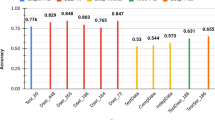Abstract
PROT-PROP is a computational tool to characterize 27 physicochemical properties of a protein along with its subcellular location (intra or extra) in a single-window application. Other significant features of this software include calculation of numerical values for hydrophobicity, hydrophilicity; composition of small and large amino acids; net hydrophobic content in terms of low/high; and Navie’s algorithm to calculate theoretical pI. PROT-PROP is an easy-to-install platform independent implementation of JAVA under a user-friendly interface. It is a standalone version as a virtual appliance and source code for platforms supporting Java 1.5.0 and higher versions, and downloadable from the web http://www.mzu.edu.in/schools/biotechnology.html. PROT-PROP can run under Windows and Macintosh Operating Systems. PROT-PROP is distributed with its source code so that it may be adapted or customized, if desired.
Similar content being viewed by others
References
Aftabuddin, M., Kundu, S. 2007. Hydrophobic, hydrophilic and charged amino acid networks within protein. Biophysic J 93, 225–231.
Ahmad, S., Sarai, A. 2004. Qgrid: Clustering tool for detecting charged and hydrophobic regions in proteins. Nucl Acid Res 32, 104–107.
Ali, V., Nozaki, T. 2007. Current therapeutics, their problems and sulfur-containing-amino acid metabolism as a novel target against infections by amitochondriate protozoan parasites. Clin Microbiol Rev 20, 164–187.
Almlof, T., Gustafsson, J.A., Wright, A.P. 1997. Role of hydrophobic amino acids clusters in the transactivation activity of the human glucocorticoid receptor. Mol Cellular Biol 17, 934–945.
Betney, R., McEwan, I.J. 2003. Role of conserved hydrophobic amino acids in androgen receptors AF-1 function. J Mol Endocrinol 31, 427–439.
Bhasin, M., Garg, A., Raghava, G.P. 2005. PSLpred: Prediction of subcellular localization of bacterial proteins. Bioinformatics 21, 2522–2524.
Bradshaw, R.A. 1989. Protein translocation and turnover in eukaryotic cells. Trends Biochem Sci 14, 276–279.
Burley, S.K., Petsko, G.A. 1985. Aromatic-aromatic interaction: A mechanism of protein structure stabilization. Science 229, 23–28.
Cedano, J., Aloy, P., Perez-Pons, J.A., Querol, E. 1997. Relation between amino acid composition and cellular location of proteins. J Mol Biol 266, 594–600.
Creighton, T.E. 1993. Proteins: Structures and Molecular Properties, 2nd Edition, W.H. Freeman & Company, New York.
DeAngelis, P.L, Glabe, C.G. 1988. Role of basic amino acids in the interaction of binding with sulfated fucans. Biochemistry 27, 8189–8194.
DeLano, W.L. 2002. Unraveling hot spots in binding interfaces: Progress and challenges. Curr Opinion Structural Biol 12, 14–20.
Gasteiger, E., Hoogland, C., Gattiker, A., Duvaud, S., Wilkins, M.R., Appel, R.D., Bairoch, A. 2005. Protein identification and analysis tools on the ExPASy server. In: Walker, J.M. (Ed.) The Proteomics Protocols Handbook, Humana Press, New Jersy, 571–607.
Gill, S.C., von Hippel, P.H. 1989. Calculation of protein extinction coefficients from amino acid sequence data. Anal Biochem 182, 319–326.
Gonda, D.K., Bachmair, A., Wunning, I., Tobias, J.W., Lane, W.S., Varshavsky, A.J. 1989. Universality and structure of the N-end rule. The J Biol Chem 264, 16700–16712.
Gregory, A.P., Dagmar, R. 2003. Protein motifs. In: Gregory, A.P., Dagmar, R., Waltham, M.A. (Eds.) Protein Structure and Function, 4th Edition, New Science Press, London, 89–101.
Ikai, A.J. 1980. Thermostability and aliphatic index of globular proteins. The J Biochem 88, 1895–1898.
Kyte, J., Doolittle, R.F. 1982. A simple method for displaying the hydropathic character of a protein. J Mol Biol 157, 105–132.
Lobry, J.R., Gautier, C. 1994. Hydrophobicity, expressivity and aromaticity are the major trends of amino acid usage in 999 Escherichia coli chromosome encoded genes. Nucleic Acids Res 22, 3174–3180.
Manavalan, P., Ponnusamy, P.K. 1978. Hydrophobic character of amino acid residues in globular proteins. Nature 275, 673–674.
Meierhenrich, U.J. 2008. Amino acids and the asymmetry of life. In: Advances in Astrobiology and Biogeophysics, Springer-Verlag, Berlin, Heidelberg, New York.
Nakashima, H., Nishikawa, K. 1994. Discrimination of intracellular and extracellular proteins using amino acid composition and residue-pair frequencies. J Mol Biol 238, 54–56.
Nozaki, T., Ali, V., Tokoro, M. 2005. Sulfur-containing amino acid metabolism in parasitic protozoa. Adv Parasitol 60, 1–99.
Ora, S.F., Baker, D. 2003. Conserved residue clustering and protein structure prediction. Proteins: Str Func Genet 52, 225–235.
Ota, M., Shimizu, Y., Tonosaki, K., Ariyoshi, Y. 1998. Role of hydrophobic amino acids in gurmarin, a sweetness-suppressing polypeptide. Biopolymers 45, 231–238.
Qiu, X., Janson, C.A., Blackburn, M., Chhohan, I., Hibbs, M., Abdel-Meguid, S. 1999. Cooperative structural dynamics and a novel fidelity mechanism in histidyl-tRNA synthetases. Biochemistry 38, 12296–12304.
Rashid, M., Saha, S., Raghava, G.P. 2007. Support Vector Machine-based method for predicting subcellular localization of mycobacterial proteins using evolutionary information and motifs. BMC Bioinformatics 8, 337–345.
Rost, B., Casadio, R., Fariselli, P., Sander, C. 1995. Transmembrane helices predicted at 95% accuracy. Protein Sci 4, 521–533.
Sevier, C.S., Kaiser, C.A. 2002. Formation and transfer of disulphide bonds in living cells. Nat Rev Mol Cell Biol 3, 836–847.
Shortle, D. 1992. Mutational studies of protein structures and their stabilities. Quarterly Rev Biophysics 25, 205–250.
Varshavsky, A. 1997. The N-end rule pathway of protein degradation. Genes Cells 2, 13–28.
Wang, J., Sung, W.K., Krishnan, A., Li, K.B. 2005. Protein subcellular localization prediction for Gramnegative bacteria using amino acid subalphabets and a combination of multiple support vector machines. BMC Bioinformatics 6, 174–183.
Zhang, H.Y. 2007. Exploring the evolution of standard amino-acid alphabet: When genomics meets thermodynamics. Biochem Biophy Res Comm 359, 403–405.
Author information
Authors and Affiliations
Corresponding author
Rights and permissions
About this article
Cite this article
Senthilkumar, B., Sailo, S., Guruswami, G. et al. Prot-Prop: J-tool to predict the subcellular location of proteins based on physiochemical characterization. Interdiscip Sci Comput Life Sci 4, 296–301 (2012). https://doi.org/10.1007/s12539-012-0143-8
Received:
Revised:
Accepted:
Published:
Issue Date:
DOI: https://doi.org/10.1007/s12539-012-0143-8




